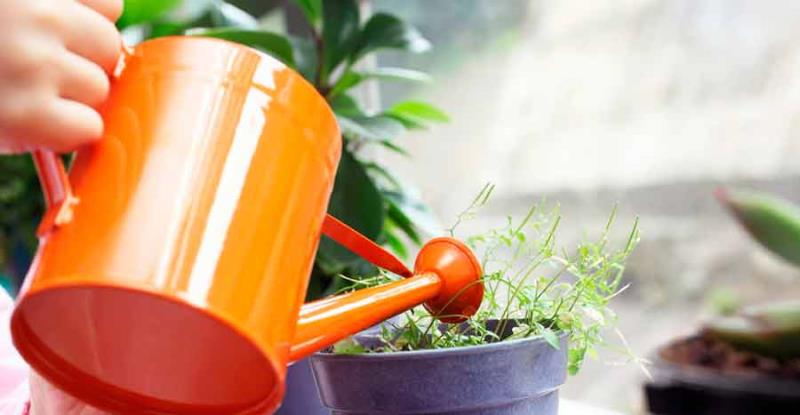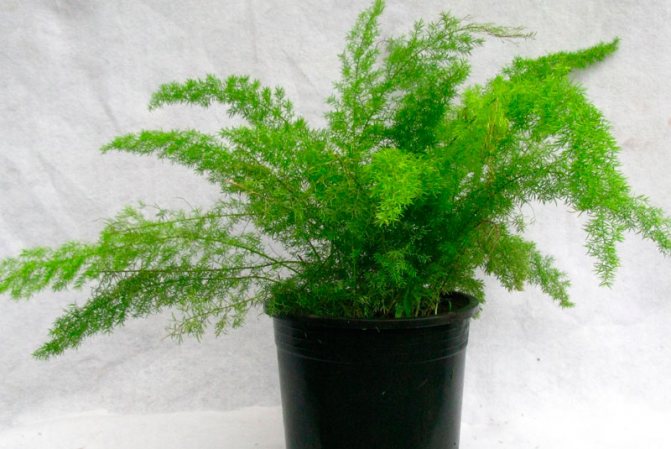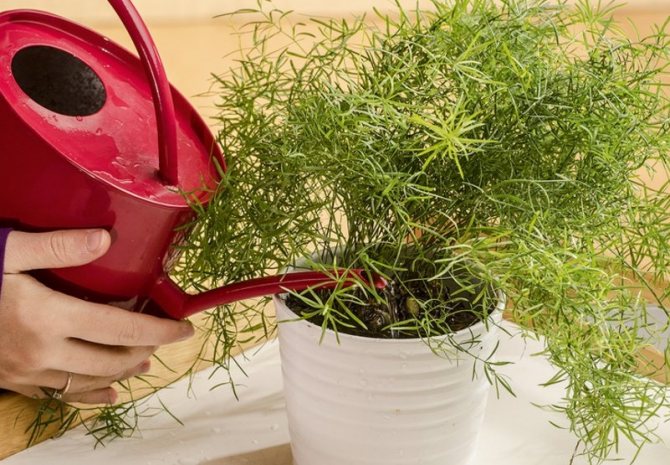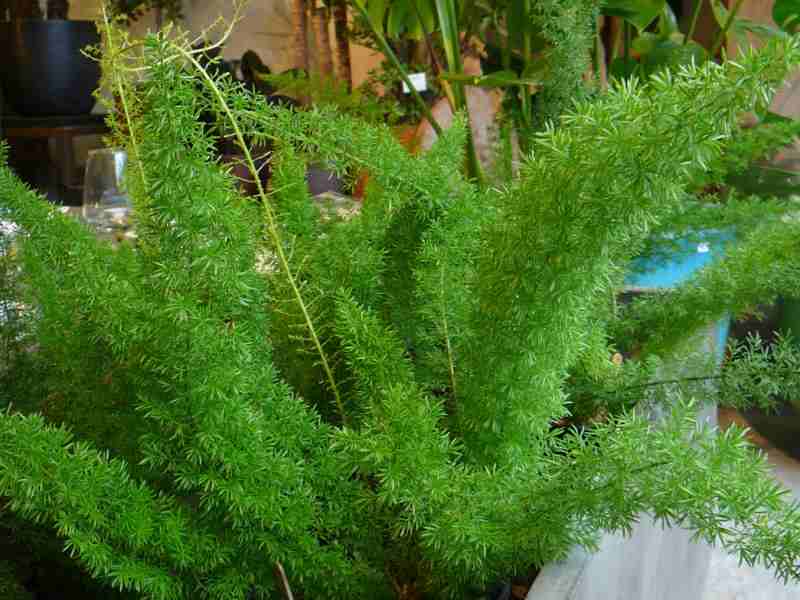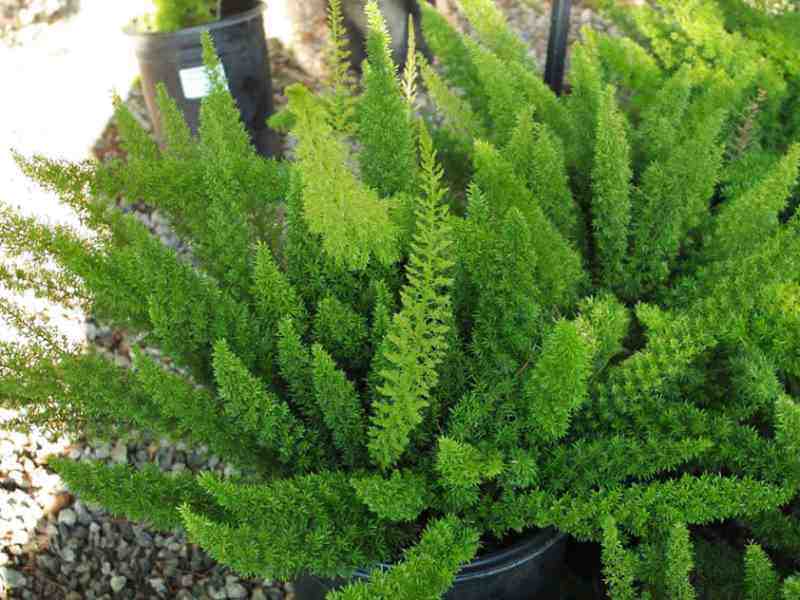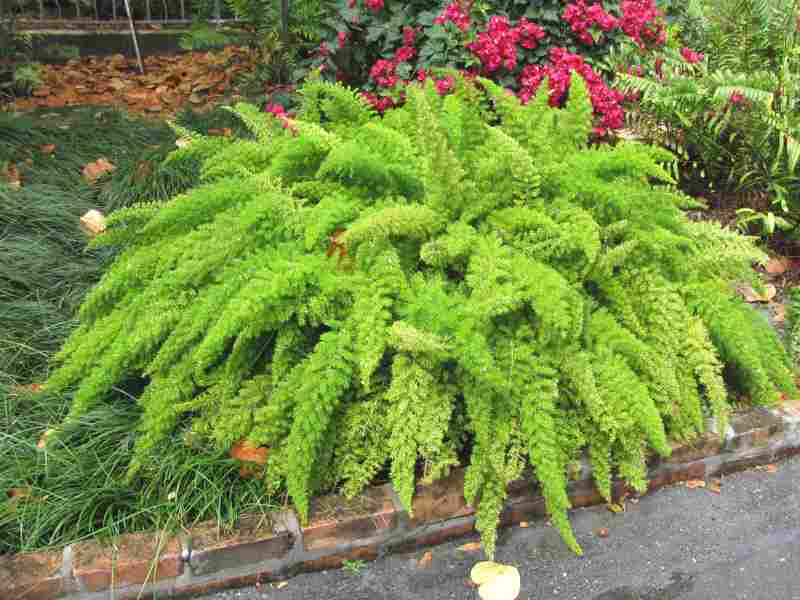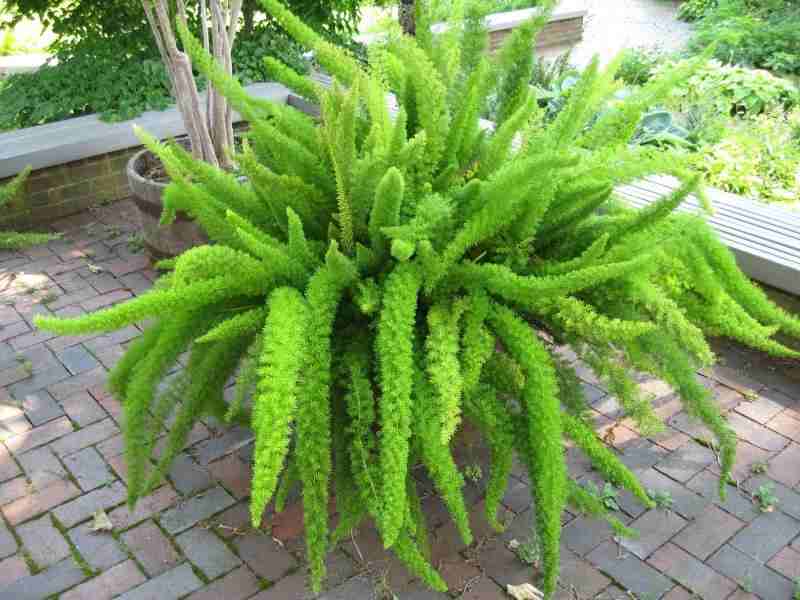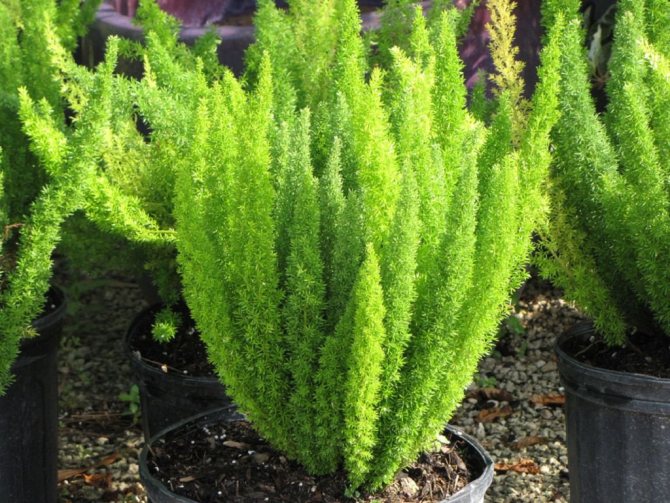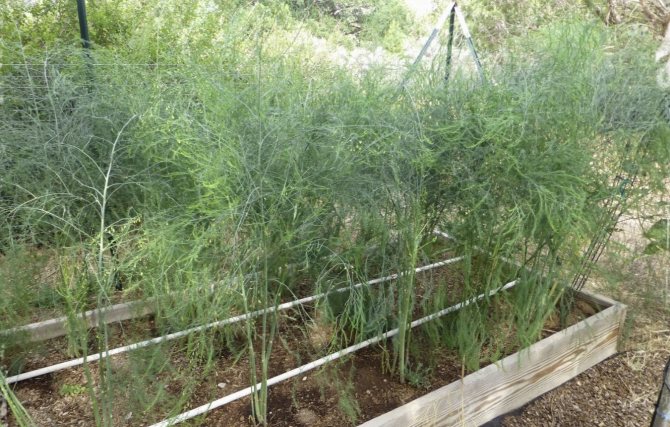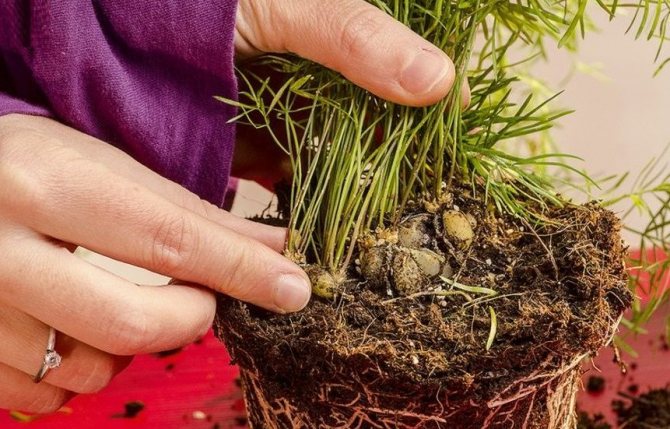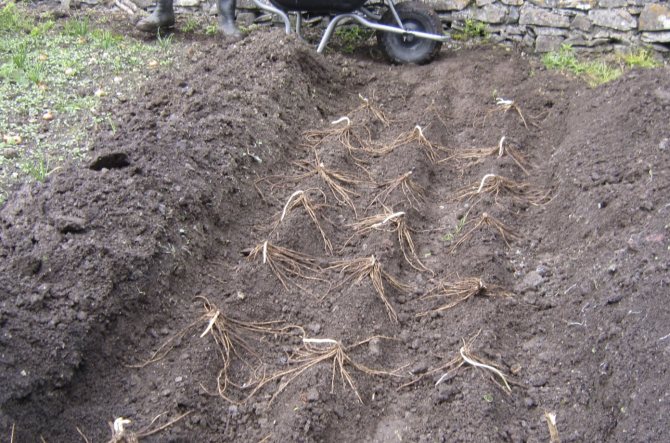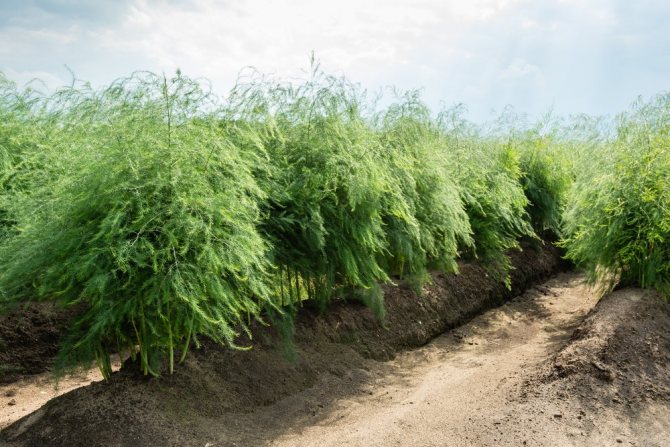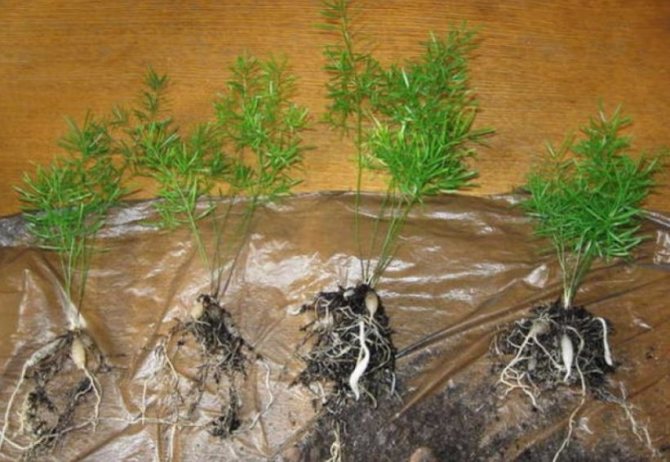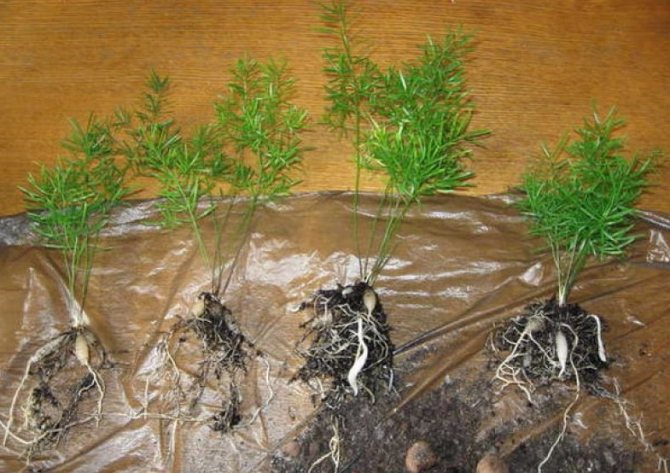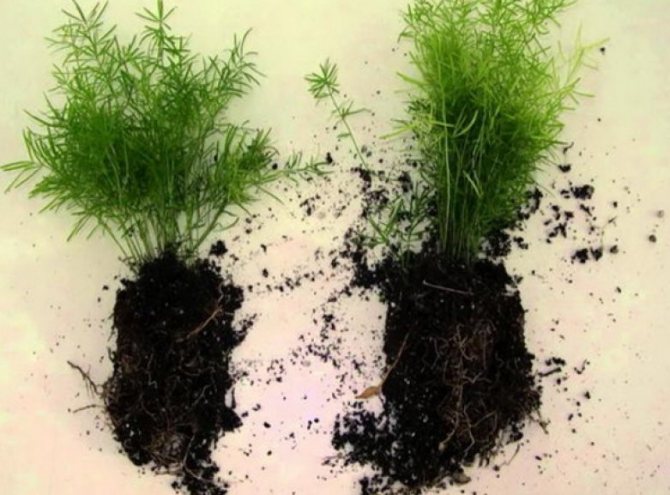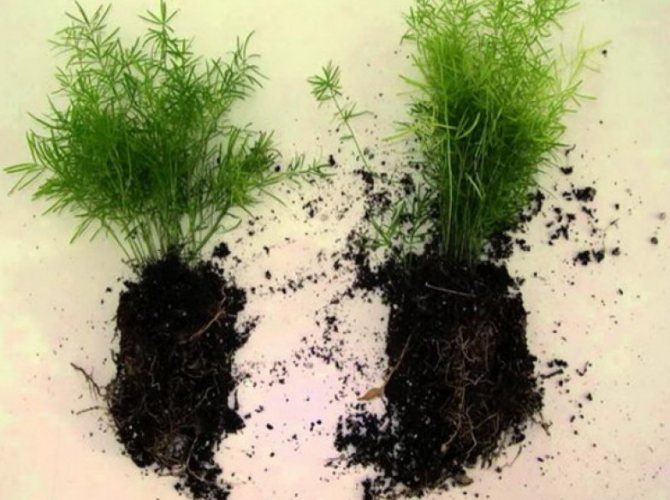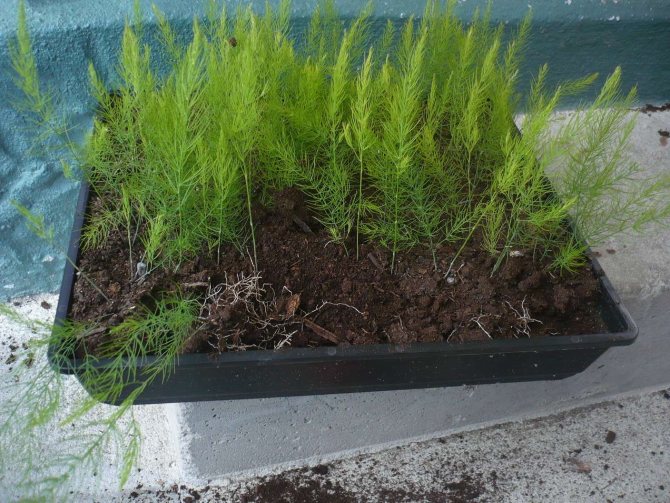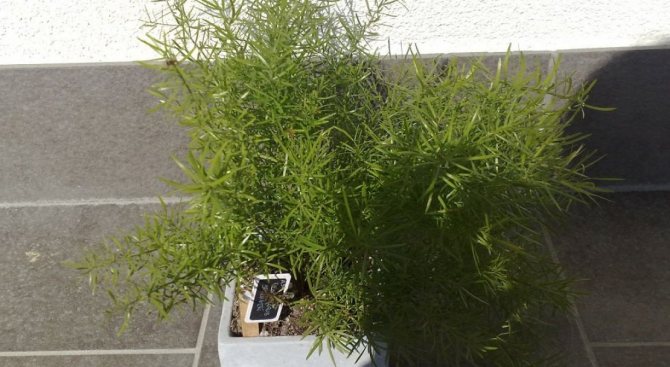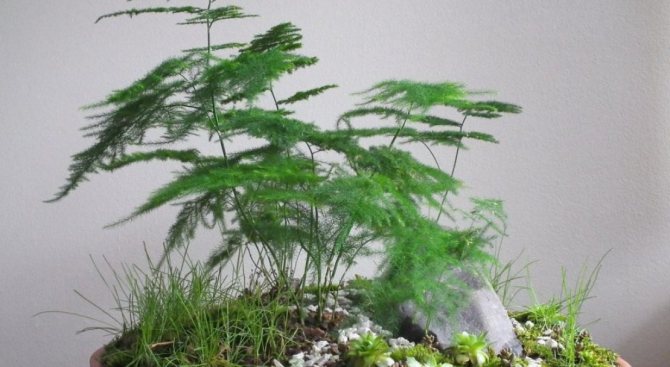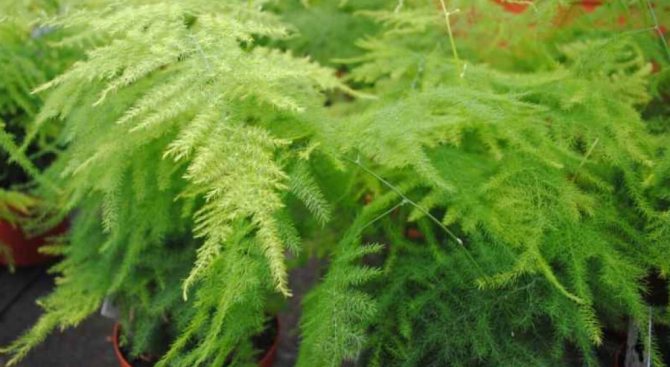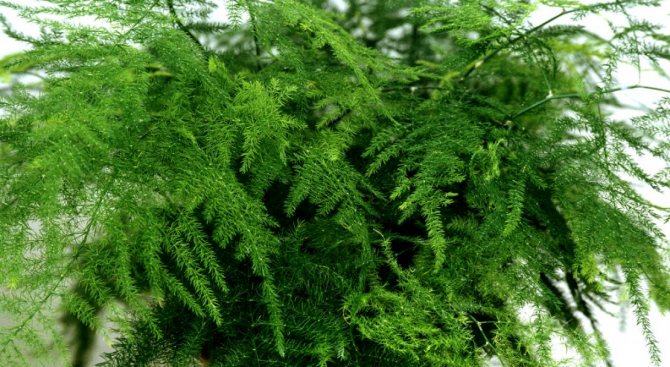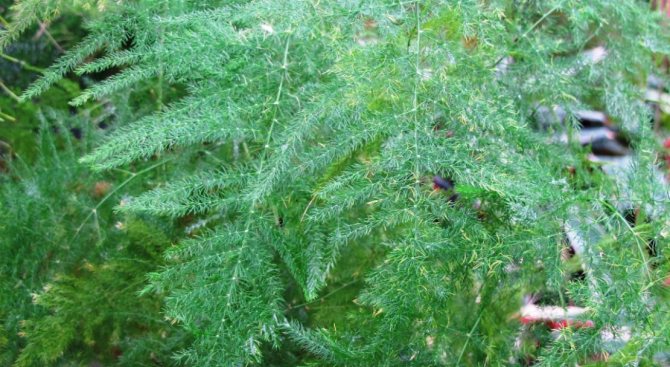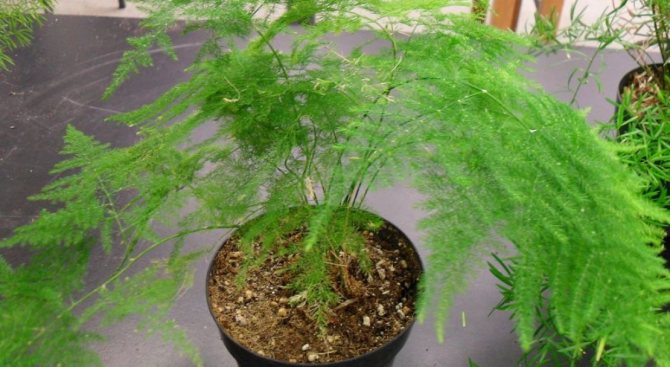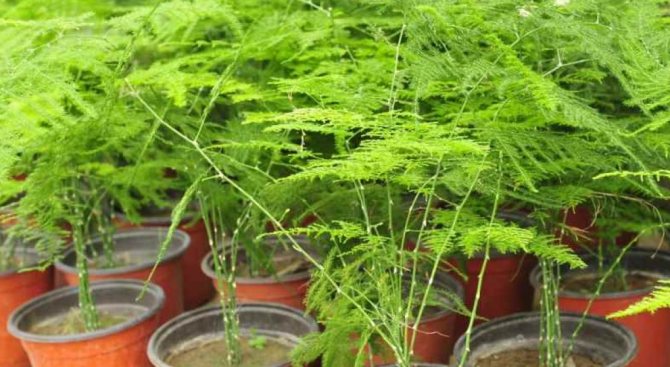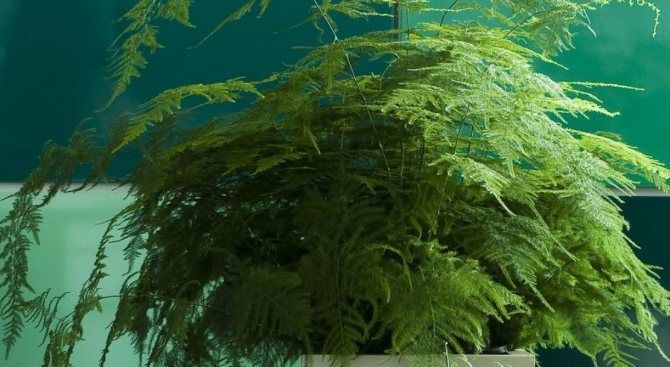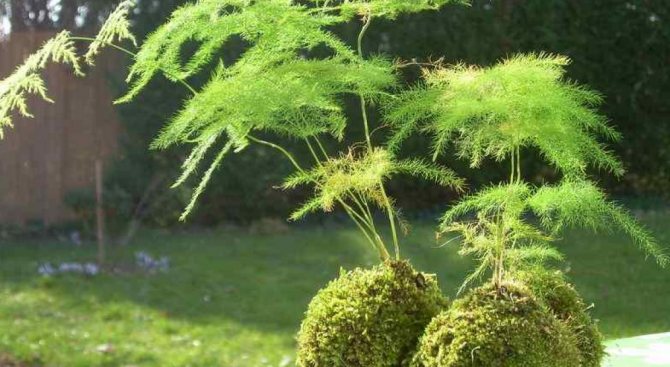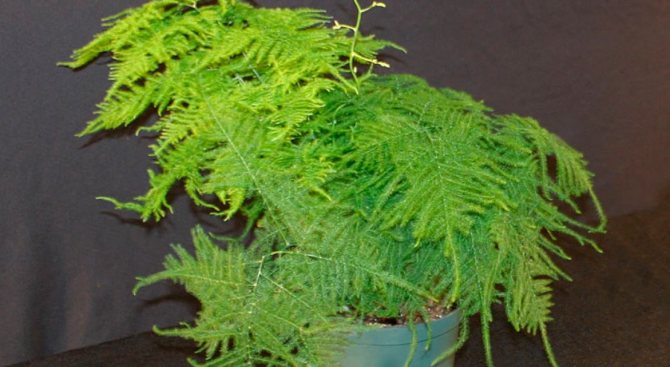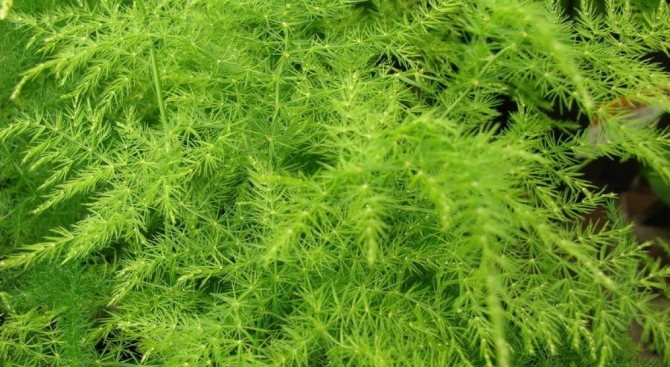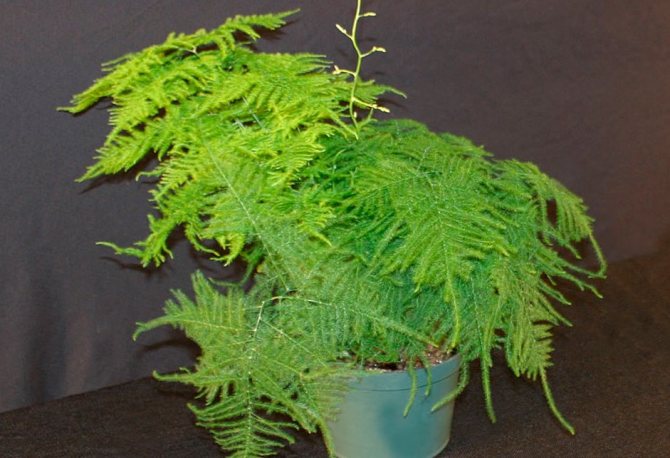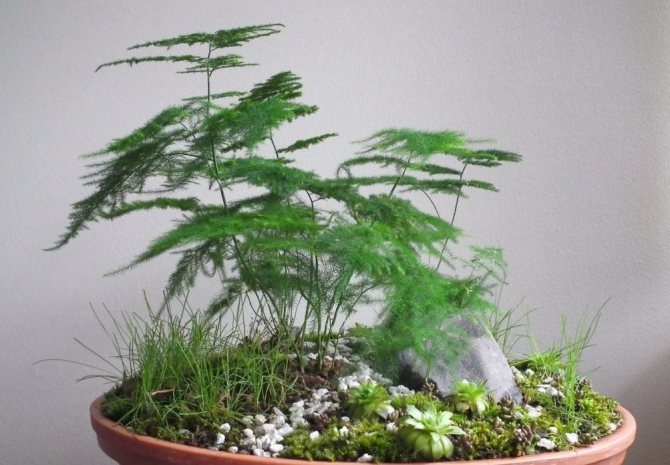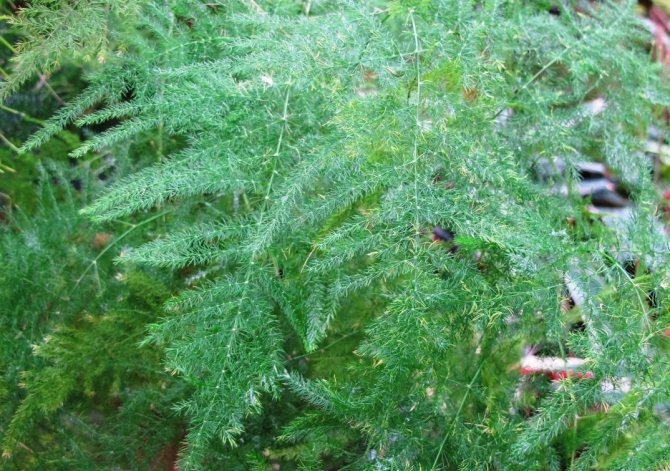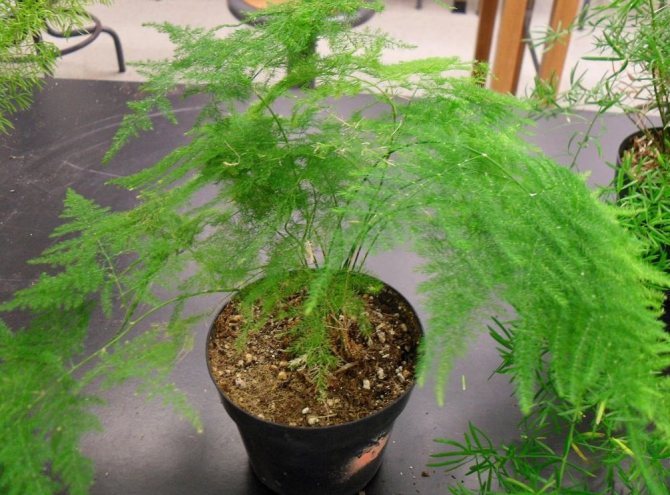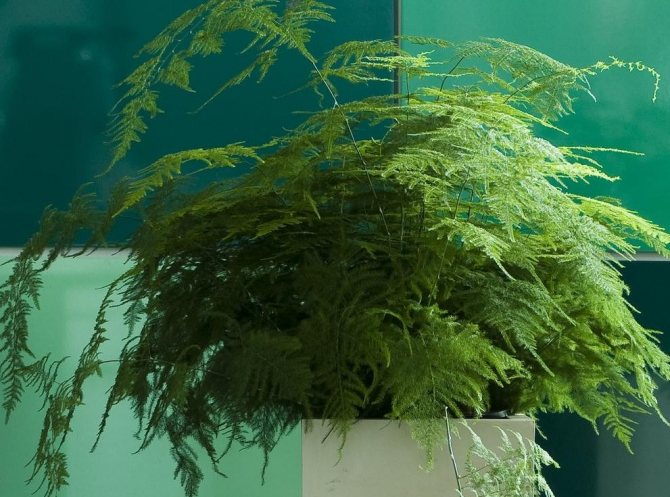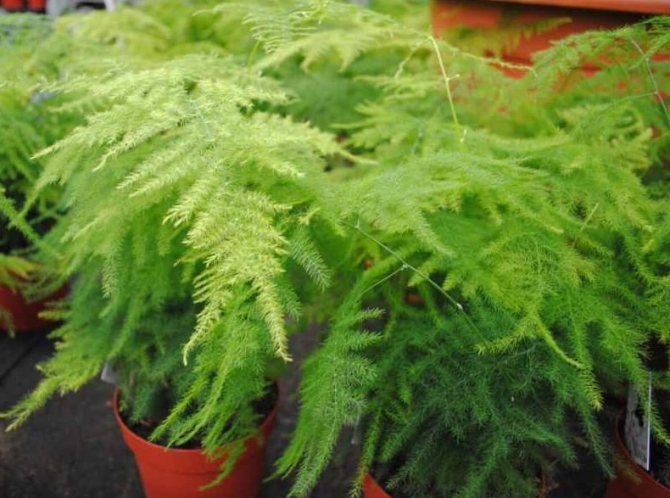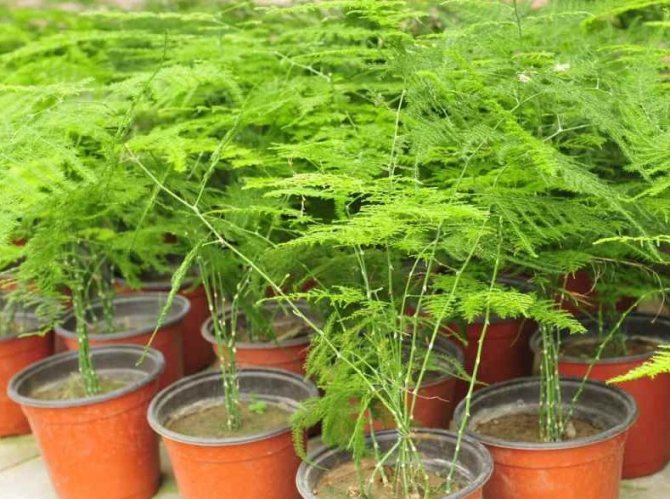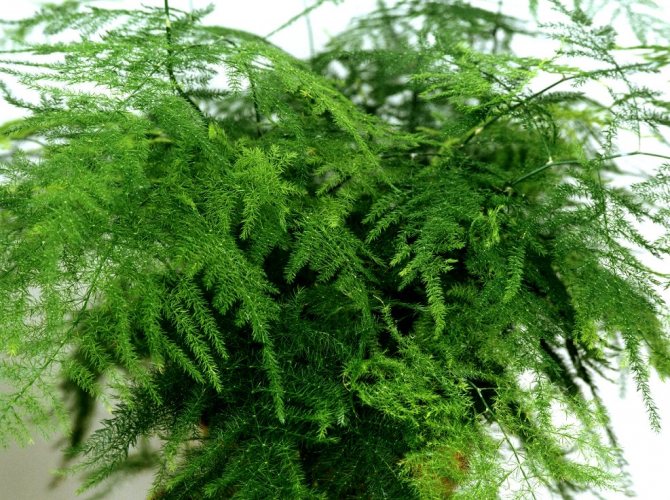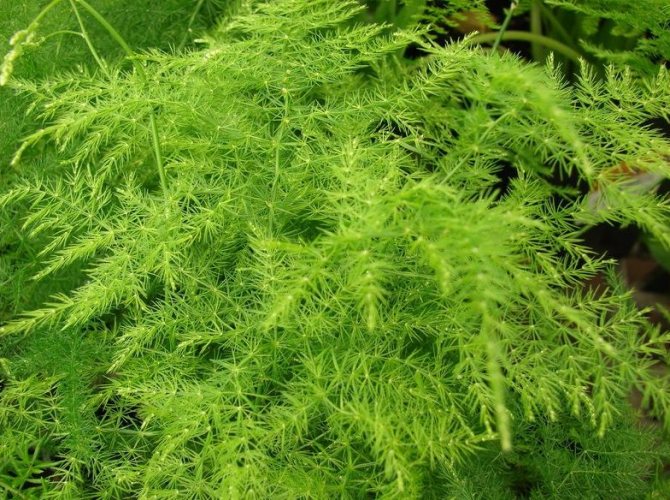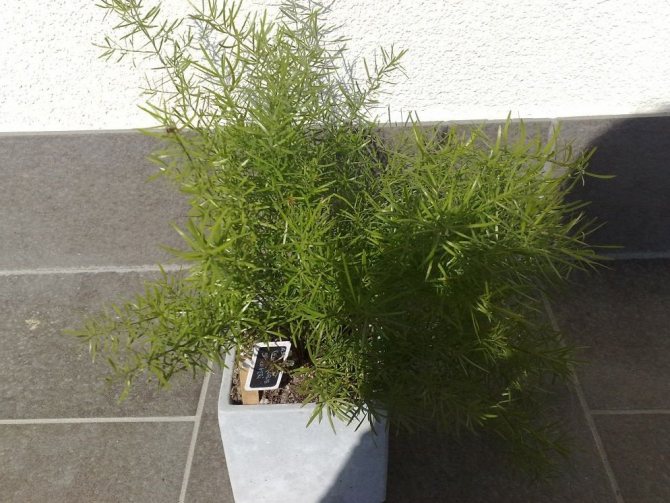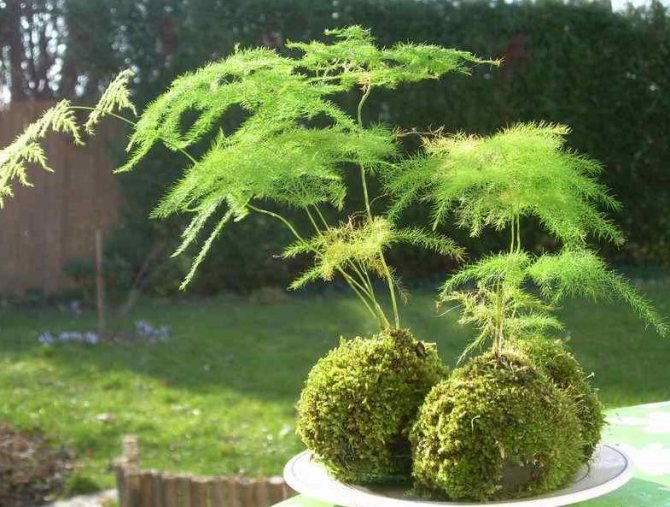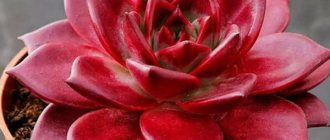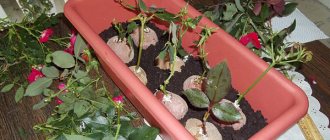Asparagus is an unpretentious perennial plant of the Asparagus family. They are often grown in the home due to their ease of care and decorative appearance.
Its lush shoots resemble feathers. Asparagus blooms with small white flowers, in place of which red or black fruits are then formed.
Like any other flower, asparagus needs a timely transplant to maintain its health and decorative appearance. In this article, we will take a closer look at this process and answer the questions when, how and why it should be done.
Care and maintenance at home: what the flower likes and what not
Green branches can be 20 centimeters or more in length, thanks to the dense small leaves, they seem fluffy. The pot is placed on the window, placed in a hanging planter, and a picky green miracle perfectly decorates any corner of the house or a country terrace.
But, for example, crescent asparagus in nature grows in height up to fifteen meters, with artificial cultivation, its size is much more modest - no more than four meters.
It is better to place the flower on the windowsill of the east or west window, but if this is not possible, place it a little further from the “south” window. The plant will not be comfortable next to radiators and heaters.
Caring for a flower cannot be called difficult, so novice growers will like its cultivation. The average temperature at which the asparagus will be comfortable is 22C, in winter it is taken out into a cool room, with a temperature of 14-15C. Humidity should be moderate, the pots should not stand in direct sunlight, otherwise the pet will die.
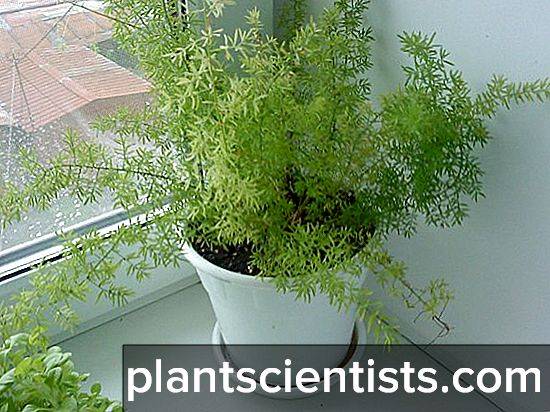
Flower care is very simple.
They water it often, but little by little, preventing the soil from drying out, for this, its moisture is monitored daily. It is not necessary to spray with cold water, this can be done only on hot days, although the shower helps to wash off the dust and refresh the plant. Moss and expanded clay will help maintain moisture in the pan, but excess water must be poured out of it.
From spring to late summer, asparagus is fertilized with complex mineral fertilizers no more than once every two weeks, it is recommended to alternate them with organic ones. Later, feeding is not stopped, only they do it less often. In winter, one top dressing per month is enough. The soil should be loose, slightly acidic.
Due to the rapid growth, asparagus should be transplanted once a year in the spring, otherwise the fast-growing roots will be cramped in the old pot. Bare branches can be cut off, they will not grow, but new shoots will appear soon.
Aphids and spider mites are formidable enemies of the plant. It can get sick and die from the contact of remedies on the leaves.
Summer flower care includes a warm shower and frequent exposing of the planter to fresh air. When taking it out into the garden or on the balcony, remember that the plant must be exposed in the shade or partial shade, and in no case in a draft. Protect the flower from stress and gradually accustom it to new conditions.
Helpful information! Having bought a plant, as they say "from hand" do not be too lazy to transplant it and the sooner the better.So you will protect it from possible pests in the soil and be sure that the soil in which it grows contains all the minerals and trace elements necessary for growth.
Diseases and pests
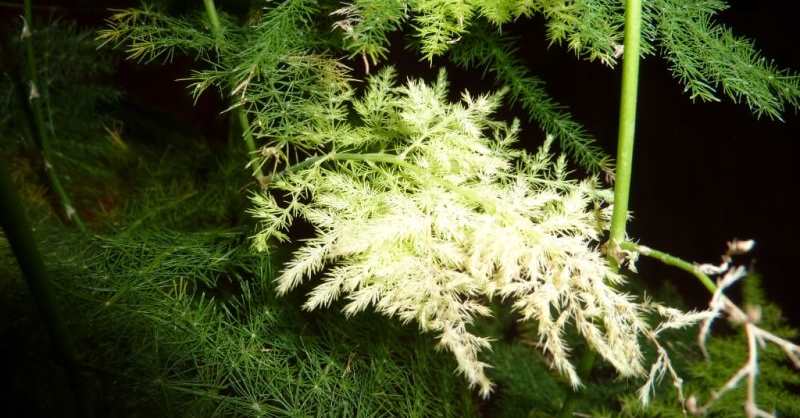

We can say that this flower is not too susceptible to attacks of insect pests and diseases. But still, some problems may arise when growing it.
For example, asparagus is very afraid of attacks from scabbards, aphids and spider mites. The problem is that asparagus is difficult to cure insects with insecticides, and therefore it is quite difficult to remove pests.
But if the plant is attacked by thrips, then you can get rid of them. It is possible to determine that thrips have attacked a flower by the yellowing of the foliage and its discoloration. The flowers become ugly and irregular. The plant begins to stagnate very much and may even die. You can simply treat sick asparagus with Karbofos.
It happens that gray rot affects asparagus. You can notice a grayish fluffy bloom on the flower. The plant can get sick due to sudden changes in temperature, high humidity, or excessive watering. Providing the flower with proper care can be saved. If the plant is very badly affected, then you can try to treat it with Bordeaux liquid or copper oxychloride.
A number of problems can also arise when growing:
- If the flower is placed under the sun, then the foliage and stems will certainly begin to turn yellow. The sun can even kill the plant. This can happen due to too dry air, as well as due to excess moisture.
- A pot that is too tight and full of roots plus too much moisture can cause root rot.
- On the other hand, if the flower lacks light, then this can lead to leaf fall. It is necessary to put the flowerpot in a well-lit room or on the east window.
- If the flower never blooms, then this is not a cause for concern - at home, asparagus may never bloom.
- Also, due to the lack of light, asparagus shoots can stretch and become thin. You just need to rearrange the flowerpot to another place, to a brighter light.
Which breeding method to choose
It is difficult to say which method is the most effective and acceptable at home. Even among experienced florists there is no consensus on this matter. Some recommend propagating the plant using seeds, others by dividing the bush. Those who choose the first method need to stock up on time and patience, since adherents of a different planting method will get lush, full-fledged plants much faster. Each method has its own disadvantages and advantages, you also need to take into account the type of flower.
At home, it is recommended to propagate by seeds asparagus feathery, sickle, garden and others, but there are varieties, including old plants, which quickly recover after dividing the bush, and even rejuvenate.
Propagated by cuttings
Propagating asparagus by cuttings at home is difficult and troublesome. If you still want to succeed, use the same algorithm of actions as when planting rose cuttings:
- Cuttings should be cooked in early spring.
- Planting material is placed in small containers filled with river sand (wet).
- The containers are covered with foil or glass and left in a warm, dark place.
A month or two and your cuttings will take root, but do not forget to regularly ventilate and spray them. If roots appear, they are transplanted into flower pots with universal soil for flowers.
Features of seed reproduction
Seeds can be sown regardless of the season, but there are not very many who want to grow flowers in this way.To avoid unnecessary costs for additional lighting at home for germinated seedlings, they are planted in late winter - early spring.
When the plant fades, reddish berries appear on it. The berries can be picked by yourself or purchased at a flower shop. Seed material gives good results not only in the first year, but also after several years, but only if stored in a dry place.
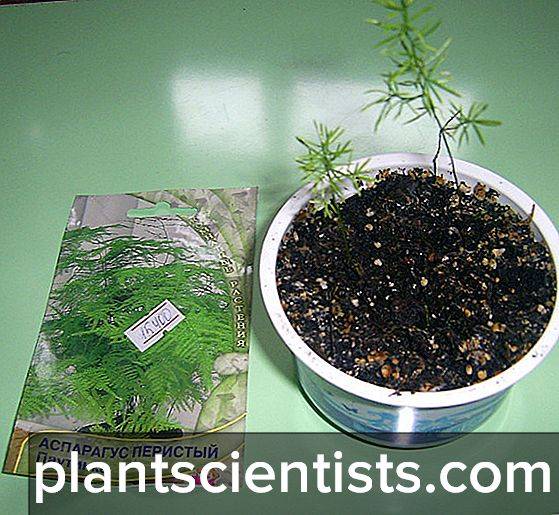

Seed propagation.
In order for the seeds to "wake up" faster, they need to be soaked for twenty hours in warm water, there is no need to introduce any growth stimulants.
Leafy or greenhouse soil, humus and sand taken in equal amounts, or universal soil from a flower shop will be the best medium for seed germination. Seeds are sown not deeply, slightly moisten the soil, and cover the container with glass or foil. It is better to take tinted glass, or to remove the mini-greenhouse away from sunlight. Remember to regularly spray and ventilate your seedlings to keep mold from developing.
Recommendations for beginners:
- make sure that the air temperature is within 21C - 23C;
- spray only with settled water using a spray bottle;
- air the seedlings frequently.
Have you been able to organize the care at home correctly? This means that sprouts will appear in a month. When their height is about ten centimeters, the sprouts dive into separate small pots, where they grow for three to five months. Then they need to be transplanted into large pots, where there is drainage and special soil is prepared.
The root system of the plant grows very quickly in size, so do not cover the soil to the edge of the pot, over time it will begin to rise and fill all the empty space.
We divide an adult bush into several small ones
This is the simplest and therefore the most popular breeding method. The seemingly painful procedure for a plant, at first glance, not only does not harm, but on the contrary, is useful.
Sickle asparagus, Meyer, and other varieties multiply at home by dividing the rhizomes into two, and sometimes four parts, but this must be done very carefully.
For thorough care, the plants are transplanted into a larger pot in the spring. Taking into account the peculiarities of the root system of an overseas guest, it is better to use the transshipment method, it allows minimizing trauma to the root. It is at this time that it is best to divide the root into several parts.
Having shaken off the root, they remove the bare stems and damaged areas, separate the bush and the root, and plant each plant in a separate pot. The soil mixture should be slightly moistened so that the plant does not lock up. Excess moisture can lead to root rot and death of the entire plant.
New bushes cannot stand in the sun, shade and partial shade are recommended for them, at an optimum temperature of 15C. Caring for them should consist in regular, but not abundant watering with water at room temperature. After two weeks, complementary foods are introduced. If the plant is planted correctly, and you organized proper care for it, then in a month it will take root, and the pots with the flower are put in a permanent place. It will be a north or east window, or a table by the window with diffused light - it depends on the type of plant and its preferences. Further care for the bushes should be the same as for an adult plant.
Grow sickle and other asparagus at home, and let the care of this cute and delicate plant give you a lot of pleasant minutes and pleasure.
What do the seeds of a plant look like and where to get them?
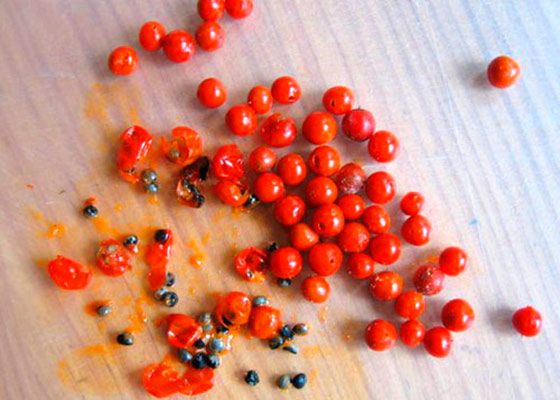

Asparagus seeds are fairly large black seeds with a thick skin. Spherical in shape, resemble black peppercorns.
Asparagus seeds are fairly easy to obtain.They are sold in flower shops at an average price of about 40 rubles, and they can also be saved by first preparing an adult plant from ripe berries.
Features of home care for an elegant "Asparagus" (asparagus)
New plants are easily accepted. But for asparagus, you still need to create certain conditions. First, remember that asparagus does not like hot air. The ideal temperature for keeping it is 15-18 ° C. At the same time, make sure that in summer the temperature does not rise above 25 ° C. In winter, when the asparagus is dormant, it is better to lower the temperature slightly, but not less than 10 ° C. The minimum temperature tolerated by asparagus is 7-8 ° C.
Proper lighting is important for asparagus
... Asparagus prefer brightly lit places. They also adapt well to partial shade. Not all asparagus species can grow in direct sunlight - only Sprenger's asparagus. It is better to shade the rest of the plant species. If your windows face west or east, then you can safely put asparagus on the windowsill. If the windows face south, then it is better to move the plant a little deeper into the room.
If you decide to leave asparagus in the room in winter, then do not place it next to a radiator or any other heating appliance
... Not only will the air in this place be too warm, it will also be excessively dry. Because of this, asparagus leaves may turn yellow.
By the way, asparagus likes high humidity
.
To achieve these conditions, asparagus can either be sprayed frequently, or simply put the pot in a pan of water. If you chose the second option, then make sure that there are pebbles or expanded clay in the pallet. These materials prevent water from evaporating too quickly.
Asparagus is very fond of abundant watering.
... In summer, it is recommended to water the flower 2-3 times a week. But in winter, it is advisable to reduce watering. Try to keep the soil slightly moist. This will be enough for a plant.
Try to feed the plant along with watering.
... As with all plants, asparagus should be fed during the summer when it is actively growing. For asparagus, one feeding once a week will be enough.
Like any other flower asparagus can bloom
, after which small fruits are formed, in which the seeds ripen. Asparagus flowers are small, white. But when breeding asparagus at home, the plant blooms very rarely.
When is it better to change the ground or pot?
Everything is simple here. The optimal time of the year for transplanting, as for most other home flowers, is the first half of spring, the beginning of a period of active growth. Simultaneously with the transplant, it is recommended to perform shaping pruning in the spring.
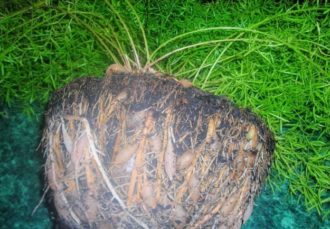

When transplanting in the spring, during the beginning of the growing season, into a larger pot the root system of asparagus has enough time to develop before the dormant period.
If this does not happen and a large volume of free soil remains in the new pot, then it may acidify due to waterlogging in the winter.
therefore you should not do a transplant from October to Marchwhen the plant has a kind of dormancy. Otherwise, the asparagus may die.
Asparagus: reproduction
Asparagus grows very quickly, therefore it can be propagated by dividing the bush
... You can divide the bush while transplanting the plant.
It should be noted that asparagus is transplanted only in the spring, when the roots of the plant literally push the flower out of the pot. Since adult asparagus grow very quickly, they can be replanted every year. But young plants can be transplanted every 2-3 years.
Also a very effective way of propagation of this plant is by seeds.
... Seeds are sown in the ground in any month.Make sure that the topsoil never dries out. To do this, cover the container with seeds with a plastic bag. If you planted asparagus seeds during a short daylight period, then you will need to arrange additional lighting so that the sprouts do not stretch out.
Useful tips, informative articles for summer residents and gardeners... Planting, leaving, harvesting. Of course, there is a lot of information about flowers, berries, mushrooms. On the pages of the site "Useful grass.ru"
Photo gallery
Due to the visual lightness and delicacy of the branches, they were actively used in floristry, and today this plant can be found in many homes.
Asparagus: reproduction by roots
This method of division has a lot of positive features. The main one is the instant obtaining of an independent plant with its own root system. After this process, the flower acclimates rather quickly, compared to techniques that require rooting or growing from seeds.
This separation is done very simply. The first step is to moisten the soil in the pot, and then remove the bush from it along with the earth. Further, the earth is carefully removed from the root system. If necessary, at this stage, the roots are allowed to be moistened with water. Then the bush is divided into several parts, forming small seedlings. It is very important that each part has healthy rhizomes and at least one growth point.
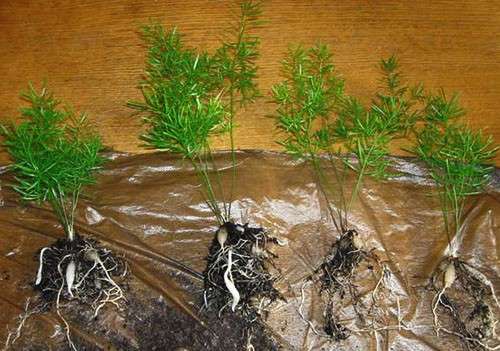

This procedure requires caution. This is due to the fact that some types of flower are equipped with thorns that can injure the epidermis of the palms. Transplanting seedlings is required in pots, on the bottom of which a drainage layer is poured, and on top of it is a nutritious soil. After the procedure, the plant is watered, rearranged in a shady place, closed from drafts and direct sunlight.
The acclimatization of seedlings will take about 30 days. During this time, it should be watered regularly, keeping the soil moist at all times.
Benefit and harm
Admirers of Indian culture and Feng Shui talk about the amazing properties of this plant. It is believed that it is able to absorb bad energy and cleanse the aura of negative emotions. In addition, asparagus perfectly cleanses and humidifies the air in the apartment.
ATTENTION: Please note that the berries of the plant are poisonous. Keep the plant away from pets and children!
Asparagus is a supplier of vitamins and nutrients in early spring when other vegetables are still in short supply. You may be interested in reading articles about Sprenger's asparagus, a white and medicinal variety of asparagus.
Asparagus: propagation by cuttings
In the period starting from the end of February and the beginning of June, you can divide the flower using cuttings. This period is due to the activation of vegetative processes. Rooting of the shoot will take about 1.5 months. The best time for cutting the cutting is the spring transplant, while last year's twigs should be preferred. For effective rooting, it is necessary to use cuttings that are longer than 15 centimeters. Moreover, the branch must be completely healthy.
Shoots must be buried in a mixture of moistened river sand, peat and perlite. The cache-pot should not be very large in volume, the best option would be a capacity of 100 milliliters. After planting the container, close the polyethylene, or cover the handle itself with a plastic glass. This is necessary so that less liquid evaporates from the surface of the mixture.
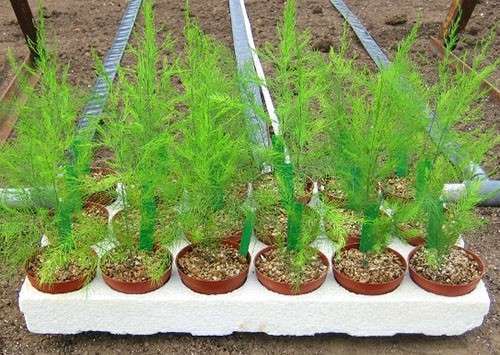

Asparagus: reproduction from a twig - planting care
To speed up the rooting process, the pots with shoots must be placed on the windowsill. It is advisable to choose a side so that direct sunlight does not fall on the plant. The best option would be the west or east side. Also, there should be no drafts in this place.
This video tells about Asparagus or asparagus: features, types, reproduction.
Temperature indicators in the room where the pots with cuttings are located should be within 20-22 degrees. The soil needs to be moistened regularly. To do this, you need to use not a watering can, but a spray bottle. Every day, the planting should be ventilated by opening the polyethylene, while it is necessary to ensure that condensation does not fall out. With this care, the root system will be formed within 30 days. You can observe this process by planting the sprouts in transparent pots or cups. After the roots are fully formed and stronger, the bush can be transplanted into a planter suitable for its size.
Difficulties in growing
Despite all its unpretentiousness, the plant may feel uncomfortable, reporting its condition by yellowing of the leaves. Most often this happens with improper flower care. There may be several reasons why pinnate asparagus turns yellow:
- insufficient or excessive watering;
- insufficient air humidity;
- excessive lighting;
- lack of nutrients in the soil;
- the need for a transplant.
New leaves will not grow back instead of yellowed and fallen ones, so all such branches must be cut off. Restoration of the necessary care and timely transplantation will quickly lead to the emergence of new young growth.
Learn about the features of watering ficus at home.
The situation is much more complicated when an attack of the following pests leads to the death of a bush:
- spider mite;
- aphid;
- shield;
- thrips;
- mealybug.
Asparagus feathery does not tolerate chemical treatment with insecticides, and they resort to it as a last resort. You need to be patient and try to get rid of the pests mechanically first. To do this, first you need to remove all dead and highly infected shoots, then the plant is washed several times with warm water from the shower to wash off the remaining insects.
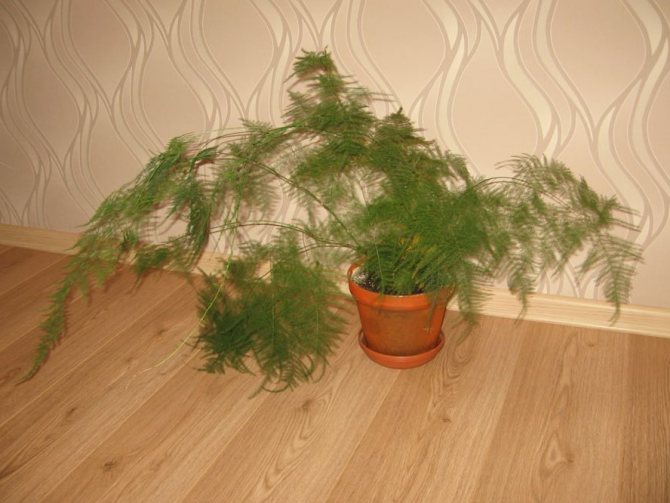

The bush must be regularly and carefully inspected and bathing carried out until the insects disappear completely. It is much easier to prevent the disease of the bush than to cure it later. Regular airing in this regard is the most effective means. Do not forget to take care of your flower, because it needs very little of your attention, and in gratitude it will delight the eye with graceful curves of fluffy openwork greenery at home and in the garden.
Asparagus - breeding at home, choosing the best way
Florists have not yet come to a consensus on the most reliable reproduction of asparagus.
Someone is sure that most surely propagate asparagus by seed, and stubbornly adheres to this option, germinating seeds and rejoicing in the appearance of the first sprouts.
Others get young bushes when dividing a plant and they call this method the simplest. Still others breed asparagus cuttings, despite the complexity of this process.
From the point of view of specialists, each of these options has its own merits. It depends a lot on the type of culture. The feathery species and the most common houseplants, Sprenger's and Meyer's asparagus grow beautifully from seed.
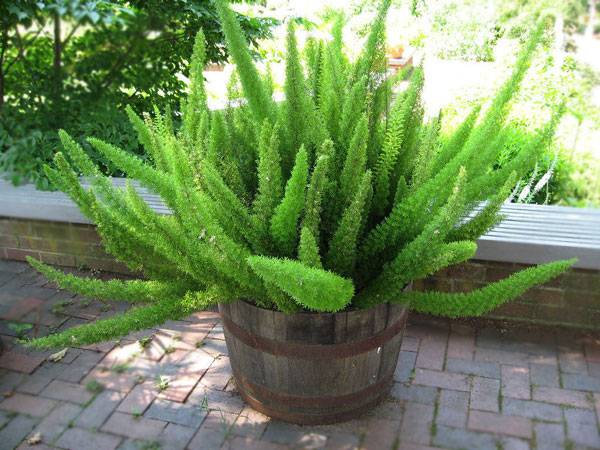

Seedlings appear quite quickly, the plant has good roots, in an adult state it is distinguished by its endurance during transplantation, transportation, and also resistance to diseases.
Professionals advise old plants that can easily recover and continue to develop after this procedure to propagate by dividing the bush.
Reproduction by cuttings does not suit all gardeners, since with this method, which is similar to rooting of cuttings of roses, not all plantings take root.
Varieties and types
Many varieties of this beautiful indoor plant have been bred, which are successfully grown by our florists. More recently, asparagus has been very fashionable to grow and grows in almost every home. Today, there are more than 300 varieties for growing at home.This plant is still popular among our florists.
Asparagus crescent
In the wild, the bush can reach 15 meters. This species has the largest size in its genus. In this case, the plant can be as little as 1 cm in thickness. In culture, the species reaches only 4 meters. The flowers are white and are collected in rare inflorescences. The color has a rather pleasant aroma.
Asparagus
This flower can be grown as an ampelous flower, or it can be placed on a decorative support. The plant is distinguished by light green, absolutely smooth stems. When grown in a room, the plant never blooms.
Asparagus Meyer
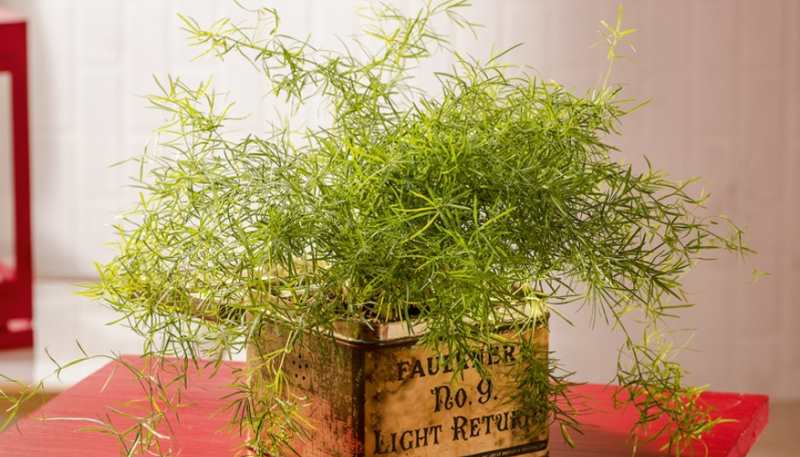

This is a bushy plant, the stems of which are decoratively covered with fluff. The flower can reach 50 cm. The plant is densely covered with the finest foliage, more like needles.
Ethiopian
It is grown as a herbaceous perennial. The plant has rather long shoots that can reach 1 meter. The leaves of this species are small, more like scales. The flower of this species smells good.
How to grow asparagus from seeds
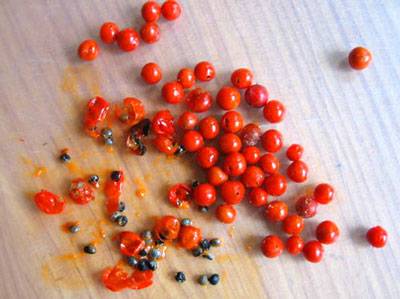

It will not be a problem to stock up on seeds: you can buy them in the store, or you can pick them yourself when the plant has faded and reddish berries appeared as in the photo.
Helpful advice: Keep the seeds dry to keep them germinating for several years.
Seed propagation is an all-season event. But most flower growers prefer to sow them in early spring. This saves on additional lighting.
How to sow seeds
You will need a small box or container into which the soil is poured, already mixed with fertilizers. It can be bought ready-made, but in any case, the earth should be warmed up, and the seeds should be treated with a weak solution of potassium permanganate. This will further protect plants from pests and diseases.
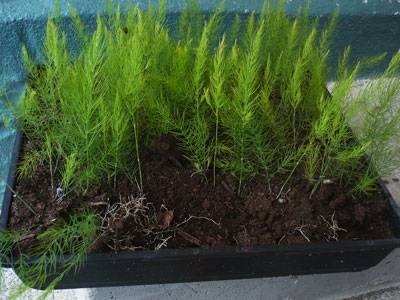

Seeds are distributed at a distance of 3 cm from each other, lightly sprinkled with moist soil.
The box is placed in a plastic bag or covered with tinted glass and placed on a windowsill.
The success of this operation will depend on the maintenance of the plantings. It is necessary that
- the temperature was comfortable (from +21 to +23 degrees);
- the soil was regularly sprayed with settled water;
- the mini-greenhouse was regularly ventilated.
If all this is observed, the first shoots can be seen in about a month. When they reach 10 cm, they should be carefully cut into small pots. 4 months later - transplant into larger pots filled with drainage and nutrient soil.
The root system of young plants is constantly growing, so you will have to transplant it into a larger pot once or twice a year.
Here are some more practical tips for growing asparagus from seed:
Description and characteristics
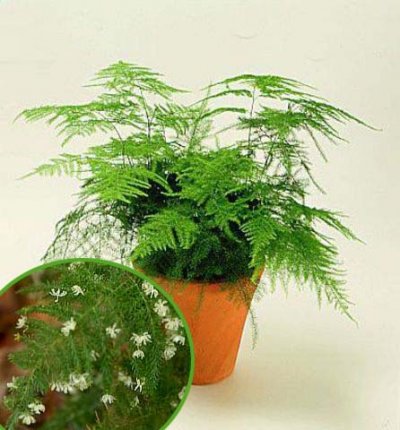

Asparagus pinnate is a perennial evergreen shrub with curly thin stems. The leaves are reduced and look like small scales.
The function of photosynthesis will be performed by modified, thin, slightly curved stems (phylloclades). They are formed in the form of bunches, on each of which there are up to 12 stems. The flowers are small, white.
Fruits are blue-black berries with seeds inside. The filamentous stems give the plant a decorative, delicate look.
In its natural environment, it is distributed in the subtropical, tropical forests of Africa.
Several photos with this plant:
Other common types of Asparagus on our website: Sprenger, Sickle, Meyer.
Dividing a bush - a simple breeding option
It seems that the division procedure should be quite painful for the bush. In fact, it only benefits him.
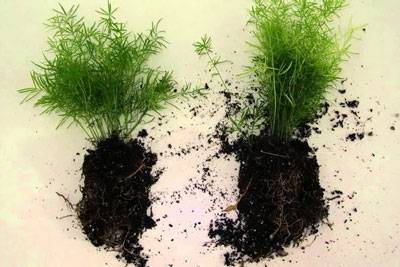

Any gardener can divide the rhizome of the bush himself into several parts.
Although this will require caution.
It is best to use the transshipment method, then the asparagus root will hardly be injured. And dividing it into parts is convenient in this case.
The root of each new bush must be shaken off, damaged stems removed and planted in a separate container. The soil mixture should be moderately moist. An abundance of water can kill a plant.
Young plantings should be placed in a shady corner, it is desirable that the temperature is not higher than +15 degrees. Bushes need regular watering, and after a couple of weeks they need to be fed.
After a month of careful care, pots with asparagus new settlers can be moved to a permanent place. Now they can easily tolerate both diffused light and the conditions of a north-facing window.
When is the best time to replant asparagus
Asparagus is a perennial crop characterized by unpretentious care and high winter hardiness. A vegetable can grow in the same area for up to 20 years without requiring a transplant.
Check out how to grow asparagus.
But, if the gardener wants to plant a crop or improve the fruiting process, it is necessary to transplant the vegetable to a new place. Newly planted plants require an annual change of growing location up to 5 years of age. An adult plant is transplanted every 10 years.
Also, the procedure is carried out if:
- the area where the vegetable grows has become shaded;
- it is necessary to transplant to a greenhouse in order to consume a fresh product in winter;
- the bush is too old, its fertility has decreased significantly.
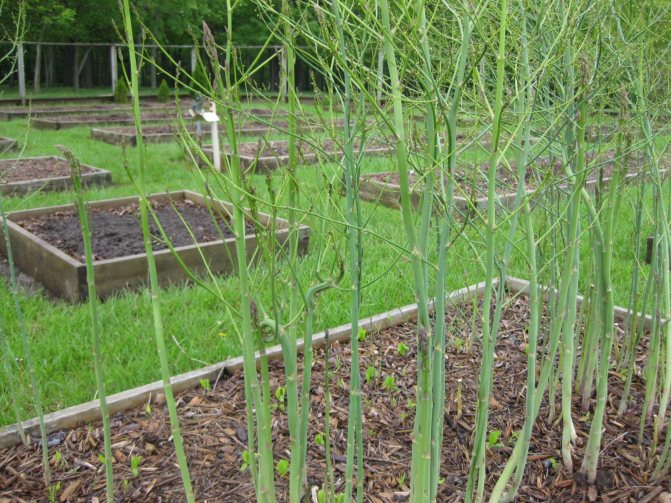

The procedure for changing the place can be carried out in the spring, when the soil is warmed up to + 5 ° С; in terms of time, this is the period from late March to mid-April. The timing of transplanting in the fall depends on how quickly the aerial part of the plant turns yellow - this is the period from the beginning to the end of October. The main thing is to have time to carry out all the necessary procedures 2-3 weeks before frost.
The most difficult method is propagation of asparagus by cuttings
This is what many think. Gardeners complain that planting material dies very often. This will not happen if you know the basic rules of the process:
- It is necessary to accurately select and cut the stalk;
- Stock up in advance with rooting utensils and properly composed soil;
- It is advisable to treat the roots with a growth stimulant;
- Do not be lazy to monitor the state of the plantings every day.
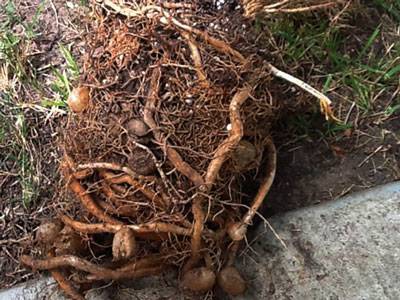

Bush cutting can be done from February to June.
At the same time, not young shoots should be taken into work, but last year's ones.
You will need a sharp knife to cut the cuttings.
Scissors are not suitable for this procedure, since the cut points will be squeezed, and later, because of this, the stalk may rot.
You need to cut small cuttings - 10-15 cm. 3-4 leaves should be left on them. The cuts should be perfectly healthy with no signs of wilting.
Cut cuttings are dropped into a pre-prepared mixture of peat, perlite and wet sand. The pot should not be too bulky. At the initial stage, a 100 ml capacity will be sufficient.
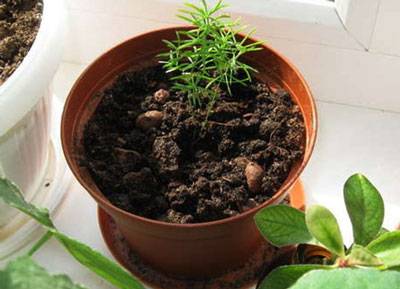

Water should not evaporate from the surface of the soil, therefore pots with cuttings should be covered with plastic cups or bags.
For the rooting process, a well-lit window sill is chosen, where there are no drafts and where direct sunlight does not fall.
Further home care consists in daily airing and spraying the soil. It is advisable that condensation does not fall on the cuttings.
After about a month, the roots should appear, they will be clearly visible if the cuttings are planted in plastic cups. From this moment on boarding, you can settle for permanent residence.
Botanical description of the plant
A perennial shrub native to South Africa. It grows in ampelous form or twists like a liana, if it finds support. Lacy phylloclades - branches that act as leaves, have the shape of a feather or a herringbone and give the perennial a resemblance to a fern. The cobweb blooms very slowly, at the age of over 10 years.The flowers are small, white, form black berries with several seeds.
Important! Asparagus berries are poisonous, so it is necessary to limit the access of children and pets to them or remove them from the bush in a timely manner.
A brief description of the plant in the table below:
| Life form | Perennial shrub |
| Roots | Horizontally growing rhizomes |
| Shoot shape | Phylloclades are long, thin, curly |
| Shoot color | Green |
| Leaf shape | Underdeveloped, scaly |
| Leaf color | Brown |
| Flower shape | Single, small |
| Flower color | White |
| Fruit shape | Round berry with 1-3 seeds |
| Fruit color | The black |
How to reproduce?
There are 3 main ways of breeding asparagus: propagation by seeds, cuttings and division.
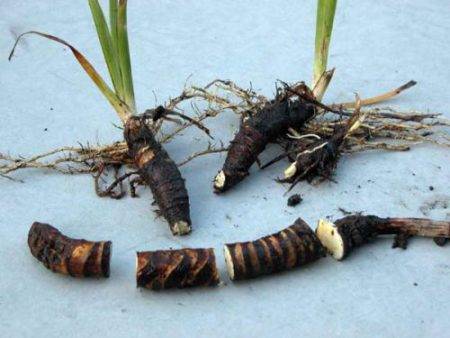

- Seeds. This method is more natural and safer for the mother plant. After receiving the seeds, plant them in the container with the nutrient mixture and cover with plastic wrap. After a while, shoots will appear. Grown asparagus seeds must be planted in separate containers.
- Cuttings. A compromise breeding method. Allows to keep the mother plant relatively intact. The shoots take root more often than shoots obtained with the help of seeds. Only large stems (at least 10 cm in length) with several growth points are suitable for reproduction. After separating the plant, treat the cuts with charcoal or cinnamon, then place the future cuttings in a greenhouse for young asparagus and ventilate regularly. Repot the shoots only after the leaves appear.
- Division. The most reliable method. Bushes often take root even if the rhizome had to be cut lengthwise.
The seeds are used by advanced growers to produce a large number of shoots. This is necessary for industrial breeding or for making bouquets. Beginners most often prefer to divide the bushes. Cutting less damages the mother plant, but you have to wait a long time for the shoots to appear (at least 6 weeks).
Best soil components
The indoor flower is unpretentious to soil components, which allows it to grow in nutritious, loose and organic soil.
The substrate for any type of asparagus can be made as follows:
- 1 part of humus;
- 1 part sand (it can be replaced with verticulite or perlite);
- 2 pieces of garden land.
When self-connecting these components, it is important to disinfect and sterilize all those that are of natural origin, this is done so that pests or pathogens of various diseases do not get into the pot.
In the absence of the necessary components, they can be replaced by a universal soil intended for indoor plants, it contains a small amount of perlite. Do not forget about drainage, which is made from gravel or expanded clay.
How to propagate: step by step instructions
Cuttings
Beginning from the last days of February and ending with the beginning of June, cuttings are chosen for the propagation of asparagus.
- Choose healthy cuttings from 10 to 15 cm long, which will easily grow root in a humid environment.
- We drip them in the spilled sand in a container - 100 ml and cover with a bag to speed up the process.
- We install it on a warm, well-lit windowsill, which will help to get root growth in a month.
- We constantly moisten the soil so that it does not dry out and ventilate it every day to avoid condensation and mold growth.
- As soon as the cuttings give roots, we transplant them into a pot with ready-made soil.
Tubers
The tuber propagation method is the most worthy, since we get several ready-made plants with a good root system at once.
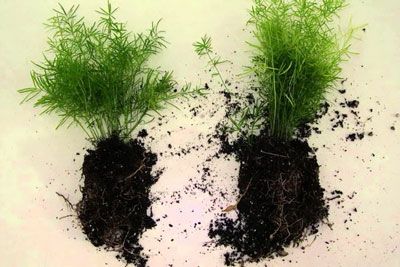

- We prepare new pots, on the bottom of which we pour drainage from expanded clay or crushed stone.
- Spill the asparagus thoroughly to remove it from the pot without damage.
- We carefully divide the plant into several parts, shed the roots and remove the damaged areas.
- We plant in prepared pots with drainage and sprinkle with nutritious soil.
- After seating, shed again and place the pots in partial shade.
- During the month, water moderately and do not fertilize.
Thanks to this breeding method, asparagus rejuvenates and maintains the growing season.
Attention! Each plant must have healthy roots and a growing point.
Seeds
If the seeds are purchased from a store, you need to pay attention to the expiration date. Good germination gives seeds harvested the day before. from the bush and immediately planted. The only drawback is that such seeds do not retain the properties of their parents if they are hybrids.
- Soak the seeds in warm water for a day or two, then spread evenly on moist soil and sprinkle gently with a thin layer.
- Cover with glass or a bag.
- Place in a dark place. Germination temperature - 23 degrees.
- Ventilate every day. Water by spraying. The emergence of seedlings is 25-35 days.
- When the first leaves-needles appear, light is added.
- After a month, they dive into small pots, after 4 months - into larger pots.
Post-intervention care
Asparagus is not very fond of being disturbed, so acclimatization will be required at first. During it, the shoots of the plant can turn yellow and even dry out. To help the plant cope with stress, it must be placed in a shaded area. You should also protect it from drafts.
All this time, it is necessary to keep the soil moist - not overdried, but not overly moist. Fertilizing at this time is not recommended., since you can burn the roots if they are cut off.
The unique structure of the asparagus plant
It is worth starting with a detailed examination of the structure of the plant itself. What many growers and flora lovers considered the tough elastic stems and needle-like leaves of asparagus are actually called phylloclades or cladodia. In fact, the entire green part is modified stems, on which white or pinkish, small flowers appear annually, and red, orange or, depending on the species, black berries with seeds inside ripen.
Where are the leaves? If you look closely, you can find them too. These are dried triangular scales on the stems, which in some species take the form of thorns.
No less interesting is the underground part of the asparagus, consisting of elongated bulbous tubers and thin roots. Thanks to the tubers, asparagus can accumulate and retain moisture, nutrients and multiply.
The genus asparagus unites about 300 species of perennial plants. Africa is considered the homeland, it grows in nature in India, on the Mediterranean coast of Europe, in the Far East. The first image of a plant dates back to the 3rd century. BC. Even the ancient Egyptians cultivated this culture and eaten it. After all, asparagus growing in an apartment belong to the same genus as vegetable asparagus, only to other species. Ornamental asparagus began to be grown a little over 100 years ago.
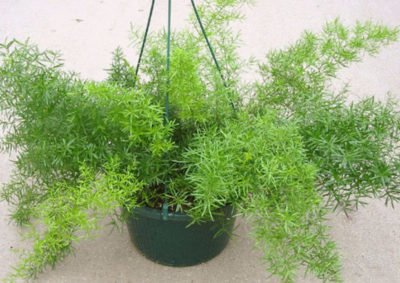

Asparagus is prized for its delicate lush greenery
The culture is distinguished by its species diversity: it is represented by herbaceous plants, large shrubs or vines. The characteristic features of asparagus are branched shoots, small flowers, a fruit in the form of a berry, a powerful tuberous root. Most asparagus lack green leaves; their role is played by flattened needles located in the axils of small scale-like leaves.
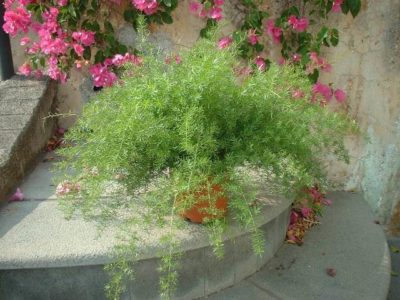

Ornamental asparagus are of the same genus as vegetable asparagus
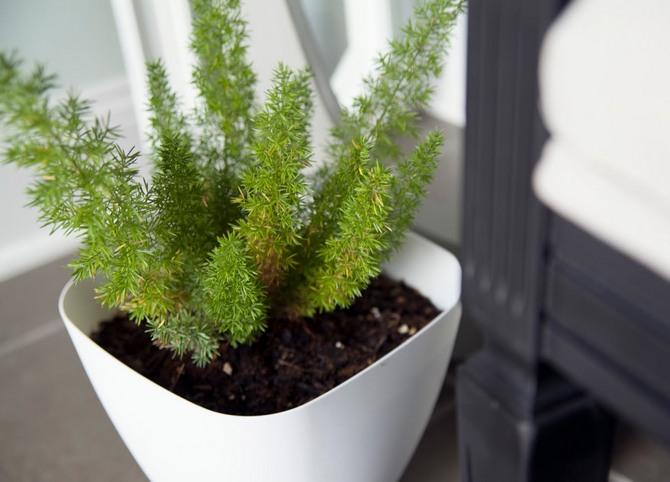

With good care, the flower grows up to 40 cm and lives for more than 10 years.
We suggest that you familiarize yourself with: Kobeya planting and care in the open field - kabeya flower wintering
Asparagus adapt well to the conditions of detention, it is not difficult to grow them at home.
Comfortable growing conditions
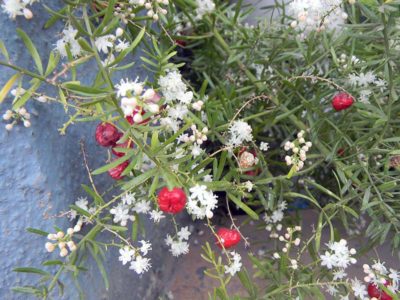

When choosing a place for your green pet, one must take into account that not only dry and hot air is harmful to him, but also a draft.
Asparagus is hygrophilous. In spring and summer, once every 3-4 days, when the topsoil dries up, it is watered with warm water. To create a humid microclimate, place a container with water next to it or place a pot in a tray with wet expanded clay.
In winter, watering is reduced. The flower is very fond of daily spraying, and not only in summer, but also in winter. Asparagus can be given a warm shower once a week.
After watering, be sure to loosen the soil, thereby providing air access to the roots.
Asparagus tubers absorb and accumulate moisture well, so the plant does not suffer with a short drought.
Top dressing
Asparagus is responsive to fertilization. In spring and summer, they are brought in every week, in winter - once a month. During the period of active development, fertilizing with complex fertilizers is useful. For a bright color of the crown, the branches are sprayed with a solution of the Bud growth stimulator (1 g per 1 liter). It is useful to alternate mineral fertilizers with organic ones. The rapid growth of shoots is also facilitated by the introduction of liquid bird droppings.


Mineral fertilizers in liquid form are better absorbed by plants
Top dressing should only be applied to wet soil, after watering.
Useful video
Asparagus is not only beautiful, but also useful due to its ability to purify the air. Its presence in the room helps to improve the mood and well-being of family members, soothes the nervous system.
Caring for this plant is simple, the main thing is to adhere to the recommendations on the correct watering and the location of the plant, and it will delight others with its beauty for many years.
Asparagus is a beautiful graceful plant with an openwork crown. Can be grown as bush or ampelous. It is actively used for interior decoration. It can purify the air from pathogens. Loves a lot of sunlight. It responds well to top dressing and systematic watering.
What happens if you do not transplant asparagus
If a crop grows for a long time in the same place, over time, its yield drops or stops altogether. This is due to the fact that over time, the soil on the site is depleted. In addition, due to the growth of the bush, the level of exposure to ultraviolet radiation on the plant may decrease, which will negatively affect the development of asparagus and its vitamin composition.
Asparagus is a vegetable crop that is loved by many gardeners for its decorative appearance and usefulness of the fruit. The plant does not need specific care and is easy to replant. The need for regular transplanting is not an obstacle to growing vegetables, even in small farms.
Temperature
Asparagus is a plant that does not tolerate heat well. At temperatures above 25 ° C, its growth slows down, the leaves fall off, and the decorative appearance is lost.
Asparagus does not tolerate heat well
The optimum temperature for growing it in summer is between 18 and 22 ° C. In winter, some species can tolerate a drop in temperature to 12 ° C, but it should not be lowered below to avoid disease and death of the plant.
Especially thermophilic crescent asparagus should be kept at a temperature not lower than 17 ° C in winter.
Possible problems
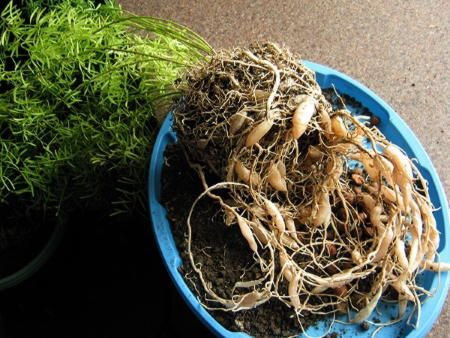

Actually, the only problem with transplanting is a powerful root system... Because of it, it is quite difficult to remove the plant from the pot.
As mentioned above, this issue can be resolved by preliminary abundant watering or with a knife, which is carefully carried along the edges of the pot.
The situation is somewhat more complicated if the roots of the plant stick out from the drainage holes of the pot. Inadvertently, they can be damaged, which will lengthen the acclimatization process and complicate rooting. In this case, abundant watering will also help.... Water is poured in several steps so that it thoroughly saturates all layers of the soil.Wet asparagus roots are more elastic and will be easier to remove from the pot and unravel for planting.
Important! You should be careful when dividing the bush. Many species of this plant are prickly and you can injure your hands during the planting process.
Note to the florist
There may be several reasons:
- Insufficient humidity in the room. The plant should be removed away from heating appliances and the number of sprays should be increased.
- Lack of iron and nitrogen. In this case, the plant requires periodic feeding.
- In the event that the edges of the leaves turn brown, there is a possibility that the plant is suffering from excess sunlight and drying out of the soil. You should move the pot with the plant to a darker place and monitor the regularity of watering.
The cause of wilting and even death of the plant can be excessive moisture in the soil and stagnation of water in the pot, which can cause rotting of the root system.
Tags: asparagus, sick, exercise, right, care
About
«Previous post
Top dressing and fertilizers
An indoor flower needs special care depending on the season:
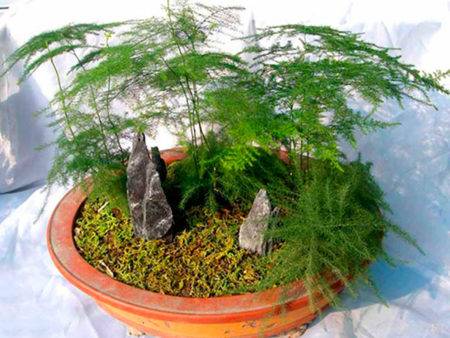

- In spring and summer. Every 2 weeks, apply liquid complex fertilizers (for example, Hyacinth) to the soil mixture. Feed the plant with a standard mineral or organic feed once a week.
- In summer. In order to have a lot of shoots, it is necessary to use bird droppings once.
- After the emergence of seedlings. Young shoots can be treated with growth stimulants (Bud). Traditionally, 1 g of the drug is dissolved in 1 liter, but it is better to clarify the dosage. Top dressing will make the crown of the flower more lush.
Ground requirements
The soil for an adult flower should be loose, resistant to fluctuations in acidity and nutritious. Traditionally, asparagus mixes have good water retention and relatively poor air permeability.
A simple substrate that you can prepare yourself is a mixture of 1 part humus and 1-1.5 parts of garden soil. However, the latter may not be loose enough and contain pests.
Another option for the mixture is humus, leafy earth and river sand (2: 2: 1). Sod can be used. Such substrates are weakly acidic and rather porous. Also, universal store soils are suitable for growing a flower.
A drainage layer is required to prevent fluid stagnation. It should occupy about a third of the pot. Use broken brick, clay, expanded clay, pebbles, etc. as drainage.

